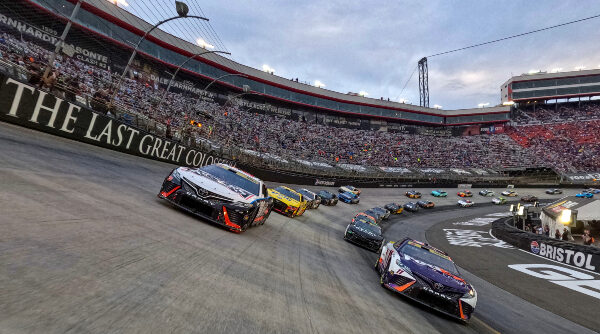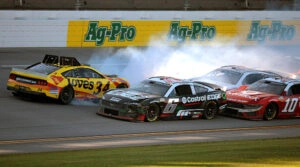Re-formatting NASCAR’s Playoff System

NASCAR has long been a staple of American sports, drawing millions of fans to tracks across the US over the years and bringing people together for the thrill of high-speed racing. However, as the sport has evolved, so too has its playoff format—and not all changes have been for the better. Just ask the fans.
NASCAR fans are renowned for their passionate reactions in the grandstands and their highly opinionated posts splashed across social media platforms. Online conversations can turn from friendly banter to brutal, tribalistic arguments in the blink of an eye. These fans are divided on a multitude of issues, from stage racing and the annual schedule to on-track incidents and the penalties handed down by NASCAR. Each topic serves as a potential battlefield where opinions clash hard. But the one topic that serves to unite a substantial body of fans is their dislike of the current playoff format.
The existing “win and in” system, introduced to add excitement and unpredictability to the sport, has increasingly come under scrutiny for its potential to undermine the very essence of racing—consistency, skill, and performance across an entire season. While the intention was to create a playoff scenario where every race mattered, it has opened the door to a paradox where a single race can matter too much.
Take, for instance, the hypothetical scenario of a race at Talladega, notorious for its high speeds and the likelihood of multi-car wrecks. Imagine last-lap chaos that results in a surprise winner, someone like BJ McLeod or J.J. Yeyley, regular backmarkers throughout the season. In the current format, that single win would secure them a spot in the playoffs, potentially knocking out a driver who has performed increasingly well throughout the season, accumulating high points in every single race. The existing system can also push a driver all the way to the Championship 4 without ever having scored a win. We saw such a scenario in the Xfinity Series in 2020, where Daniel Hemric made it to the final 4, and scored his very first win of the season after pulling a dump and run on the lead car of Austin Cindric. Hemric took home the championship.
The format has yet to backfire in such an overt and egregious way in the Cup Series, but the makings are there. For example, if a winless Brad Keselowski or Bubba Wallace had made it to the final 4 in this 2023 season and potentially won the championship over William Byron, who scored 5 wins during the regular season, or Martin Truex Jr., who was the regular season champion with 3 wins and a steady accumulation of points, how would that have played out with fans? Would they have considered the championship justified? So, it’s a ticking time bomb that NASCAR shouldn’t ignore. The sport is built on a foundation of skill, speed, and consistency, and the playoff format should reflect exactly that.
So, what’s the solution? Here are a few ideas that take the existing format and build upon it to amp up the excitement and uncertainty while rewarding steady performance.
What if a win counted toward the playoffs, but only if the driver was able to maintain a points position among the top 20 or 25 drivers throughout the season? That would eliminate the potential for a fluke win at an attrition track like Daytona which gets the driver into the playoffs with the very first race of the year, but the remainder of their season is entirely ineffective. A similar format was adopted prior to 2023 where drivers had to remain among the top 30 drivers; however, that’s almost too liberal considering the regular field is only 38 and not all lower-tier teams employ full-time drivers. The remainder of the current format could continue as is while the season moves toward a playoff field of 16 drivers based on wins or points. And the onset of the playoffs could function in the very same manner as well, with the elimination of four drivers after the Round of 16 and another four after the Round of 12. But after that, no more eliminations. The final eight would battle it out until the end with a championship decided by points, hence consistency, the very thing that defines a notable driver.
But perhaps that scenario is too easy. So, let’s look at tweaking the playoff system even further for the final eight drivers with a structure that would enhance the final outcome. Let’s call these drivers “The Great 8”— and this is where the format would change dramatically. By implementing the structure outlined below, it would heighten the excitement for fans by keeping points uncomfortably close throughout the playoffs. Additionally, it would ensure that all 8 drivers remain in the playoffs until the end, thereby maximizing exposure for their sponsors—a plus for attracting new sponsors. Furthermore, it would undoubtedly hold all playoff drivers and their respective teams to a higher standard of consistency.
The distribution of overall points would remain as it is currently across all other drivers in the field. However, for only the 8 playoff drivers in question, a specific points allocation system would be applied based on their finishing order. The highest-finishing driver among the 8 playoff drivers would receive 8 points, the driver in second place would receive 7 points, and this pattern would continue in descending order. In this manner, points would remain ridiculously close throughout the final races because the most a driver could ever lose is 7 points to the leader. For example, after three races, a potential scoring could look like this:
William Byron – 18
Martin Truex – 17
Denny Hamlin – 14
It’s easy to see how this would keep fans on the edge of their seats because the unpredictability would be heightened beyond what it currently is. And crowning a champion wouldn’t all come down to the twist of fate of just one race.
Bonus points could be added to give a driver a bit of a leg up but never enough to stretch to an overwhelming lead, such as 1 point for a stage win and 1 point for a pole. And to make that coveted pole position even more interesting, the driver with the fastest lap from the previous race could choose when they go out in qualifying order, which would allow the team to create their own strategy.
In the unlikely event of a tie at the final race of the season, the edge would go to the highest-finishing playoff driver.
Certainly, adapting to this new format may require some time and getting used to it, but fans have learned to adjust in the past when the playoff format has changed. And in this case, the math and calculations are easy, the points gap would be reduced even further to the current format, it minimizes the risk of elimination based on fluke events, and it undoubtedly enhances the experience for both fans and drivers.
by Rob White
Photo courtesy of NASCAR




